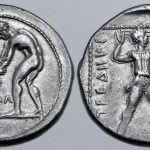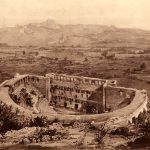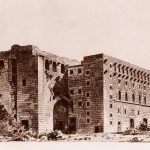History
Aspendos, one of the leading cities of Pamphylia, was founded on a high hill on the bank of Köprüçay (Eurymedon) in the present-day Belkıs Neighbourhood of Serik District, 48 km northeast of the city centre of Antalya, and expanded around the hill over time.
Some sources associate the foundation of Aspendos with the Achaean seer Mopsus around the 13th-12th centuries BC, whereas Strabo attributes its establishment to the Argives. However, recent excavations indicate that this chronology may be pushed back to earlier periods. The name of the city read as Estvediys/Estvediya on the coins of the Classical Period survived until the Early Hellenistic Period (330/300 BC). This name has been associated with Asitawandas/Asitawada, a local king known from bilingual inscriptions from the second half of the 8th century BC at Karatepe in Adana. Information on the city during the Lydian Period, corresponding to the 7th and the first half of the 6th century BC, is rather scarce. After the Persians ended the Lydian rule in 547/546 BC, the city came under Persian rule but continued to mint its own silver coins in the Classical Period. Although the Athenian statesman and general Kimon destroyed the Persian fleet anchored at the mouth of the Eurymedon River in 468 BC the Persians maintained their dominance over the region; however, Aspendos briefly became a member of the Attic-Delian League. An inscription discovered in Athens, dated to 425 BC and containing a list of tax-paying cities, includes the city of Aspendos. Aspendos, which came under the rule of the King of Macedonia in 333 BC, witnessed the wars between the generals of Alexander the Great after his death in 323 BC. Located in a region that changed hands between the Ptolemies and the Seleucids, Aspendos continued to be an independent city-state during the Roman Period.
In 79 BC, the Roman magistrate Gaius Verres plundered Aspendos along with other Pamphylian cities. Although Pamphylia, which includes Aspendos, was part of the Province of Cilicia until 43 BC, it was occasionally incorporated into the administrative boundaries of the Province of Asia. As of 31 BC, Augustus (Octavianus) left the administration of the region to the Province of Galatia. In 74 AD, Emperor Vespasianus established the joint province of Lycia et Pamphylia, which included Aspendos.
Aspendos, which enjoyed its heyday under the rule of the Roman Empire, secured its place among the most splendid cities of the region, especially owing to the construction activities in the 2nd century AD. With a range covering commodities such as olive oil, grain, textiles, wine, and notably salt obtained from a nearby salt lake and horse breeding activities, it is known that Aspendos was an important trade centre during this period. The city that maintained its economic vitality in the Christian Period was known to be renamed as Primoupolis during the time of Archbishop Tribonianus, in the 5th century AD. The city’s theatre, which held an important place in the Seljuk Period, was functionally transformed into a palace for the Seljuk Sultan Ala al-Din Keyqubad.
 |
 |
 |
 |
HISTORY OF RESEARCH
Since the 19th century, Aspendos has attracted the attention of many researchers; many travellers such as Beaufort, Fellows, Schönborn, Texier, Rott, Hirschfeld and Seiff have explored and described the city. However, the most important research in the region was carried out in 1884 by a team led by Lanckoroński.
In 1913, Italian archaeologists wanted to excavate the city but could not obtain the required permission. Subsequent studies were mostly focused on the examination of visible remains.
In 1929 H. Hörmann studied the Nymphaeum, whereas J. B Ward-Perkins studied the Aqueducts in 1955. Besides, H. Cüppers examined the grain stores in the Basilica in 1958, while H. Lauter focused his research on the Hellenistic Agora in 1968.
The studies conducted in the last two decades have focused on the Aqueducts and the Roman-Seljuk bridge over the Eurymedon River, and some repair and planning works have been carried out in general. In 2008, a team led by Assoc. Prof. Veli Köse from the Department of Archaeology at Hacettepe University, initiated surveys around the city and commenced the documentation of the theatre and other public buildings using up-to-date digital technologies.
The excavations in Aspendos began under the supervision of the Antalya Museum in 2013 and were transformed into an excavation project under the direction of Veli Köse with the decision of the Council of Ministers in 2014. These scientific excavations continued until 2021 within the scope of the project.
As of 2022, excavations were resumed under the direction of Asst. Prof. Mustafa Bilgin, a faculty member at the Department of Art History at Afyon Kocatepe University, following the granting of the status of “Excavation by Presidential Decree”. In the same year, a survey project was initiated with a team led by Mustafa Bilgin. This project, conducted with the permission of the Ministry of Culture and Tourism and the General Directorate of Cultural Heritage and Museums, aims to identify the boundaries of Aspendos’ territory.